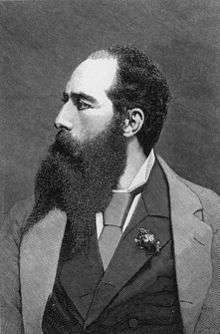Luigi D'Albertis
| Luigi Maria D'Albertis | |
|---|---|
 Luigi Maria D'Albertis | |
| Born |
21 November 1841 Genoa, Liguria, Italy |
| Died | 2 September 1901 (aged 59) |
| Nationality | Italian |
| Fields | Biology |
Luigi Maria D'Albertis (21 November 1841 – 2 September 1901) was a flamboyant Italian naturalist and explorer who, in 1876, became the first person to chart the Fly River in Papua New Guinea. He took eight weeks to steam some 580 miles up the Fly River in an Australian launch, the Neva. On board as engineer was young Lawrence Hargrave, later to become an aviation pioneer. D'Albertis kept a pet python on board to prevent his motley crew from pilfering the stores. He also fired off exploding rockets to keep any hostile natives at bay. His expedition collected specimens of birds, plants and insects. The Neva forced its way upstream until brought to a halt by the shallows. They then steamed downriver to a tributary called the Alice, and d'Albertis cajoled his crew up this river with promises of gold. Eventually stricken by malaria and crippled by rheumatism in both legs, he admitted defeat. He tried once again in the following year, but did not reach as far as before, and returned to Europe. An excellent account of d'Albertis' expeditions up the Fly in the Neva and his various political and personal problems with his contemporaries and the inhabitants of Papua are told in Goode, J. 1977 Rape of the Fly (Nelson, Melbourne).
He was born in Genoa. His cousin, fellow explorer Enrico Alberto d'Albertis, housed many of Luigi's specimens at Castello D'Albertis. The castle is now home to the Museum of World Cultures. His natural history specimens from New Guinea are in the Natural History Museum of Giacomo Doria in Genoa.
A number of reptile species from New Guinea were named in honour of d'Albertis but most have subsequently become synonyms of other species.
- Gonyocephalus (Lophosteus) albertisii Peters & Doria, 1878 now Hypsilurus papuensis (Macleay, 1877) (Papuan Forest Dragon)
- Heteropus Albertisii Peters & Doria, 1878 now Carlia bicarinata (Macleay, 1877) (Bicarinate Grassland Skink)
- Liasis albertisii Peters and Doria, 1878 now Leiopython albertisii (Peters and Doria, 1878) (Northern White-lipped or d’Albertis Python)
- Emydura albertisii Boulenger, 1888 now Emydura subglobosa (Krefft, 1876) (Red-bellied Short-necked Turtle)
Only the python carries d’Albertis’ name today.
Several of these species were described by the German naturalist Wilhelm Peters and Giacomo Doria, the Italian naturalist and founder of the Natural History Museum of Giacomo Doria.
Only Leiopython albertisii (the white-lipped python) is currently recognised as a valid species, the other three reptiles being synonymised within species described earlier, ironically two of which were described by entomologist Sir William John Macleay whose rival expedition on the Chevert, was also collecting specimens in southern Papua.
Publications
- Journeys up the Fly River and in other parts of New Guinea. Proceedings of the Royal Geographical Society 1879 (read at the Evening Meeting, November 11, 1878):4–16 (incl map).
- New Guinea: What I Did and What I Saw. Vol. I and II. London: S. Low Marston Searle & Rivington, 1880
References
- Edwards, Ian. Luigi D'Albertis 1841-1901
- Goode, John. 1977 Rape of the Fly : Explorations in New Guinea. Nelson, Melbourne. :viii+272.
- Kirksey, E. Anthropology and Colonial Violence in West Papua. Cultural Survival Quarterly, Fall 2002
External links
| Wikisource has original text related to this article: |
- Reptile Database listing for python Leiopython albertisii
- online copy of Luigi Maria d'Albertis, New Guinea: What I did and what I saw, Sampson Low, Marston, Searle & Rivington, London (1880).
|